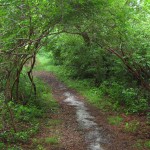Here are some thoughts from M. Scott Peck, M.D. in his book In Search of Stones:
“One age does not turn into another overnight. Between the Age of Faith and the Age of Reason there lay at least three hundred years of confusion. An old Age does not die easily. Today, firmly ensconced in the Age of Reason, we look back upon its pioneers—men like Galileo—with admiration and respect. For the Inquisition that persecuted him, we have only disrespect and find it hard to imagine how the authorities of the church could have been so narrow-minded, stupid, and downright cruel. Yet were we able to look through the eyes of those authorities at the dawning of the Age of Reason, we would not only have seen a crumbling of faith, we would also have been filled with terror at the impending disintegration of civilization and loss of all that gave meaning and coherency to life. Perhaps the greatest sins of religion are not those of faith per se but of faith threatened.” –page 6.
Here are some quotes from Carlos Castaneda in his book The Wheel of Time:
“To change our ideas of the world is the crux of shamanism. And stopping the internal dialogue is the only way to accomplish it… When a warrior learns to stop the internal dialogue, everything becomes possible; the most far-fetched schemes become attainable.” –pages 118-119.
“Whenever the internal dialogue stops, the world collapses, and the extraordinary facets of ourselves surface, as though they had been heavily guarded by our words.” –page 128.
“Human beings are not objects; they have no solidity. They are round, luminous beings; they are boundless. The world of objects and solidity is only a description that was created to help them, to make their passage on earth convenient.” –page 135.
“Human beings are perceivers, but the world that they perceive is an illusion: an illusion created by the description that was told to them from the moment they were born…” –page 137.
Here are some interesting quotes from The Tibetan Book of Living and Dying by Sogyal Rinpoche:
“To see through the eyes of the mountain eagle, the view of realization, is to look down on a landscape in which the boundaries that we imagined existed between life and death shade into each other and dissolve. The physicist David Bohm has described reality as being “unbroken wholeness in flowing movement.” What is seen by the masters, then, seen directly and with total understanding, is that flowing movement and that unbroken wholeness. What we, in our ignorance, call “life,” and what we, in our ignorance, call “death,” are merely different aspects of that wholeness and that movement. This is the vast and transforming vision opened up to us by the bardo teachings, and embodied in the lives of the supreme masters.” –page 341.
“To see death, then, through realized eyes, is to see death in the context of this wholeness, and as part, and only part, of this beginningless and endless movement. The uniqueness and power of the bardo teachings is that they reveal to us, by showing with total clarity the actual process of death, the actual process of life as well.” –page 342.
Here are some thoughts from me:
I believe that we are always in the middle of a tornado, our world collapsing, in the process of death while in the throes of life, but that we do not perceive our world in such a manner until something shakes us out of our complacency, out of our narrow-mindedness, out of our internal dialogue, and out of our ignorance. I believe that we are being gifted with one of those times of shake-up right now.
Look around; look at what is happening. Take a ride on the wings of the eagle and realize that this is the time of confusion before the dawning of a new Age. But, as the shamans, the Buddhists, and deep spiritual thinkers suggest: this collapse is constantly presented to us—we are just not aware of it. And this is where Harold Camping, the end of the world predictor, gets it wrong. The end of the world is an every day occurrence and we all have the opportunity to grab onto the freedom of that clarity every day.
If we can learn how to let go of our reason—our internal dialogue, our conjuring mind, and our description of the world as we have been taught—and open up to the realization that everything is an illusion, we can enter a new reality. We can do this volitionally, learning how to shift our perceptions and how to experience the endless movement of energy, our own included, as it flows in the universe.
Through the process of recapitulation we learn to shed our old selves, our old perceptions and ideas of the self and the world, our self-importance, our attachments to the illusions of this world that we so solidly stand upon. In so doing we relieve ourselves of adherence to beliefs that do not truly serve us if we are ready to evolve into a new understanding of life and death.
We can experience our energetic wholeness in total freedom by constantly challenging ourselves to shatter our world as we have always perceived it, by refusing to attach to the illusions of this world. Those illusions are placed upon us from the moment we are born. If we can break our fixation with reality as we have been taught to perceive it, we might just discover that what is happening in the world, every day, is nicely set up to help us shatter those illusions. Even a momentary glimpse of a different idea of ourselves offers us the opportunity to gain in awareness, to aid us in letting go—just a little bit more—of all that holds us so attached to what we believe is so important and so dear.
Today, across America, many people are waking to a shattered world, everything gone. The tornadoes that have been touching down bringing the end of the world to so many lives remind us that we cannot hold onto anything. In such a moment we are offered the experience of impermanence. So what do we do when we stand there with nothing, when our dreams and our lives are shattered, totally gone?
This is the moment of enlightenment, the moment of freedom in collapse, the experience of death in life. The big challenge is to retain the experience of this moment of death; of ourselves without attachments, without belongings, totally released from the familiar. The is the gap moment that allows us a glimpse of our eternal selves while we still stand firmly in this world.
So, can we accept the convenience of our solidity long enough to embrace the fact that it is offered as a means from which to launch our awareness, as the shamans would pose? Can we allow ourselves to embrace this moment of impermanence, as the Buddhists would call it, as our big moment of evolutionary enlightenment? Can we hold onto our experience and use it to truly shift us away from our old ideas, needs, and desires? Can we use it to enter a new Age, an Age of true Enlightenment as the deep spiritual seekers understand it?
These are the challenges that the shamans, Buddhists, and deep spiritual seekers know are the moments that teach us how to face our deaths, but also offer us the opportunity to face our lives in the same manner. These are the moments of shattering the illusions we hold onto, though what we are really being shown is that we cannot hold onto anything and we don’t need to either.
We are beings who are going to die, as the shamans say. Yes, it’s a very scary thought, but can we live each day with that foremost in our thoughts, basing our lives on that idea? Can we live beyond the illusions of this world, and enter the flowing movement of unbroken wholeness? It’s not really that hard to do, we’re already doing it, every day!
Perhaps we just haven’t fully perceived it that way yet, but we have so many daily opportunities to do so. Every day is the end of the world.
Just trying to remain aware,
Jan





